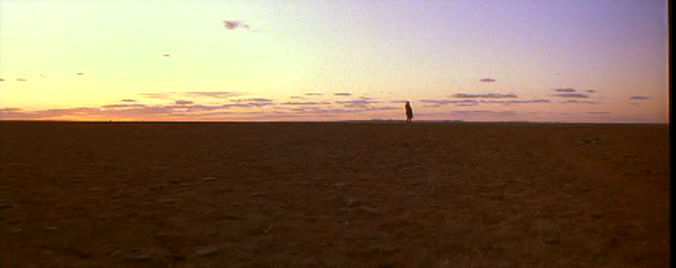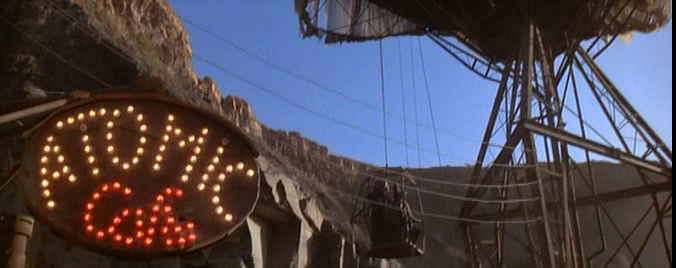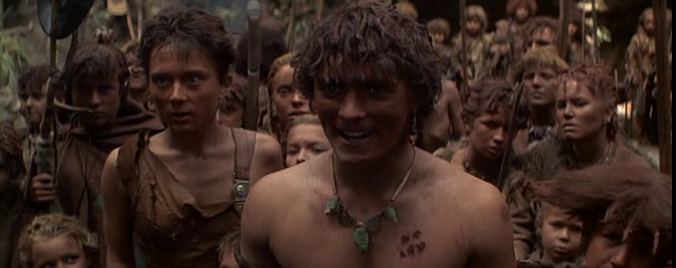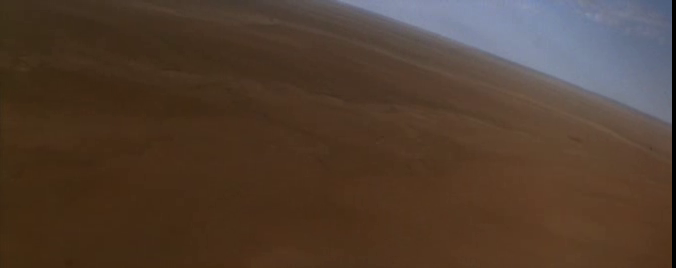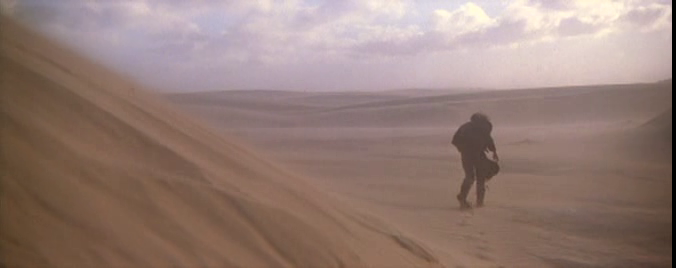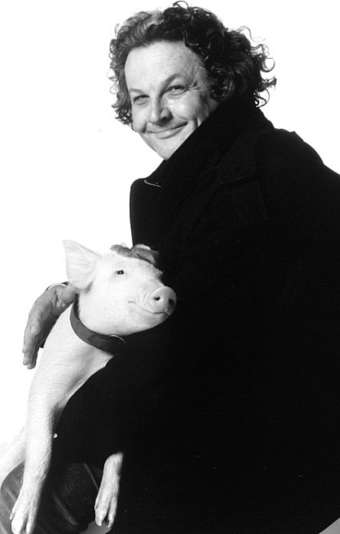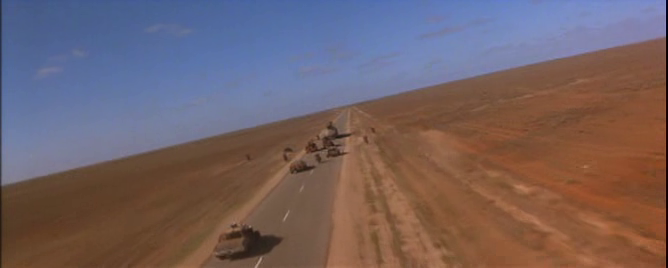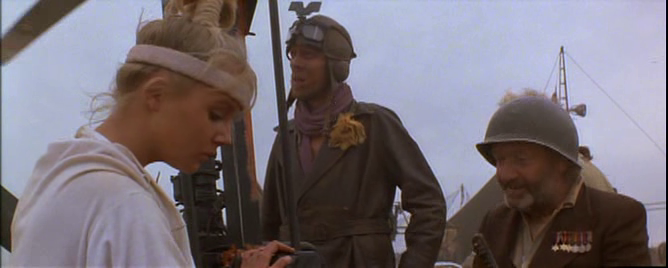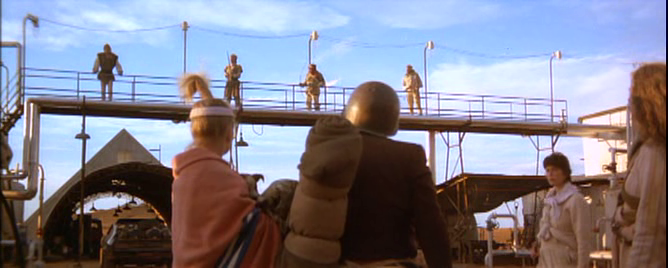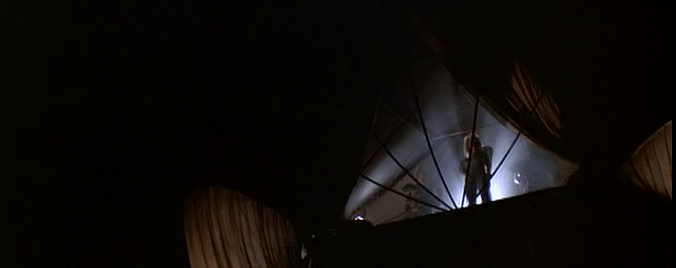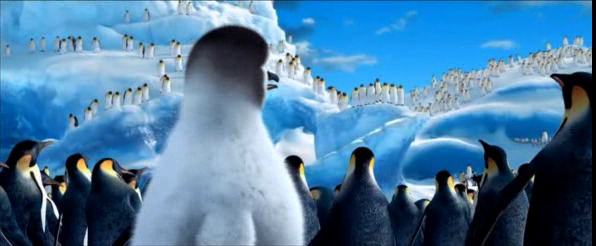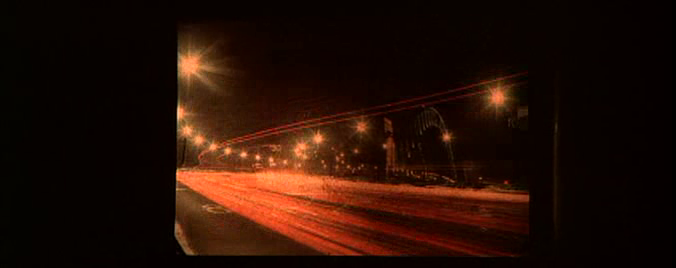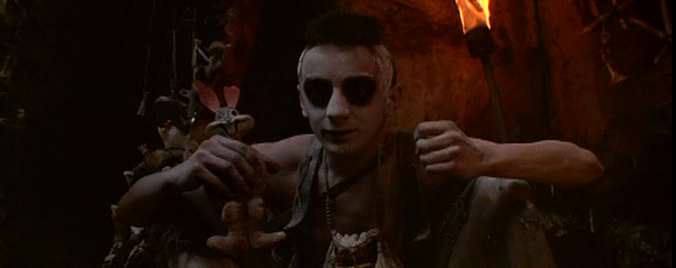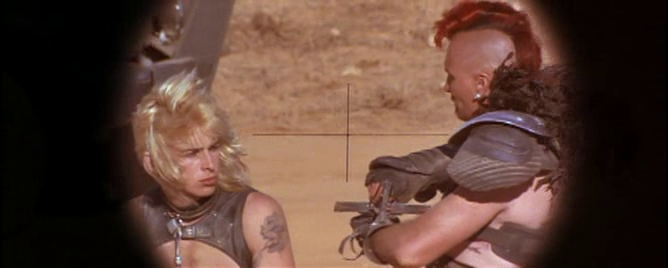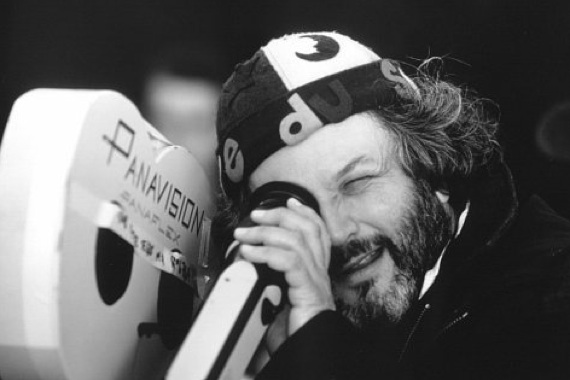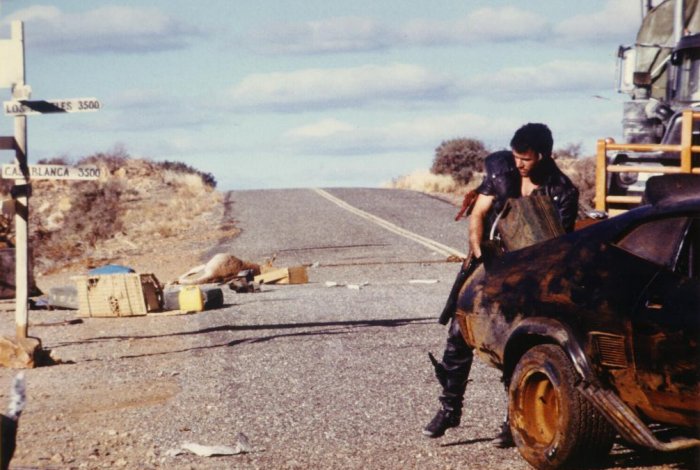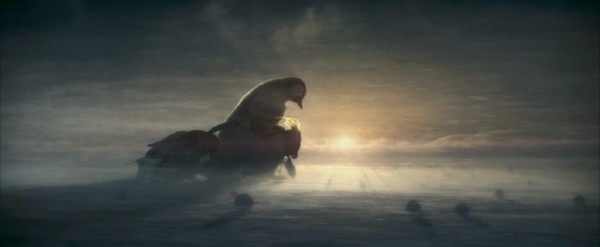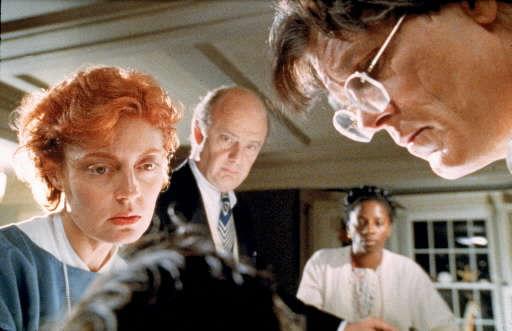It is imperfect, but what do you expect? I totally forgot about One Night at McCool's.
------------------------------------------------------------------------------------------------------------
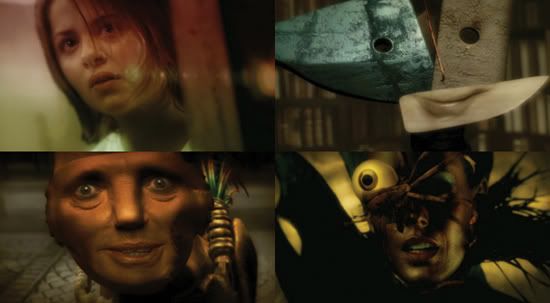
21. Mirrormask
It's interesting, and a shame, that the work in Mirrormask that most evokes the eerie appeal of director Dave McKean's graphic art is his construction of the “real world” of Helen’s circus life. Once she and the viewer tumble into Maskland or whatever that world is called, the movie loses some charm and becomes a, while sometimes awe-inspiring, fairly formulaic sequence of dreamlike strangeness. Think Alice in Wonderland. Helen's reality is captured wonderfully, though, and the cast at large acts beautifully, particularly the young woman playing Helen, whose face beams with humor and a sense of emotional truth. The effects and design are never less than witty and weird. I've always liked Alice-type stories, where the actuality of the hero/heroine's fantastic story, while still expressing the character’s mental or emotional life, is up for question, peppered with clues that hint at both answers. And this one is more evocative of the frustrations and inner turmoil of a young woman (and in particular, her relationship with her parents) than any other I can think of that came out this decade (including Spirited Away, which is great in many ways, the ravishing but mopey Where the Wild Things Are, and the also-Gaiman-originated Coraline, which was fun).
------------------------------------------------------------------------------------------------------------

20. Atanarjuat
A tangled, oft-called "Shakespearean" supernatural family drama: love and generations and violence and spirits and all that, some say its unexpected popularity is due to its being an Inuit film and how many of those are there? It definitely doesn’t seem like white America’s cup of tea: it looks like a PBS documentary sometimes, featuring an unfamiliar language and an alien culture. Nowadays, people just blink when you talk about it. So despite the film's possession of qualities that have ensured films of lesser quality to remain popular, it has sadly become the victim of being a passing exotic fancy to the public. I implore us to not forget this movie. I am bowled over at the naturalism of its breadth. It is enormous, yet so unassuming. The straightforward nature of the digital footage gives everything a casual pall that makes the spiritual dimension more curious and the epic plotting more involving. The chase sequence is one for the books.
------------------------------------------------------------------------------------------------------------
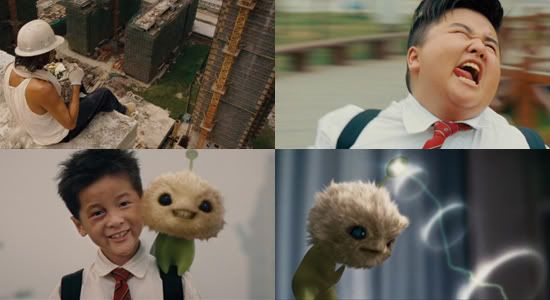
19. CJ7
A film full of signals and fantasy, where boys are girls, death is life, where balls and dolls are alien dogs. It’s a kid film and works as such. The pre-K humor and cuteness factors are there, frequently executed in slightly off-kilter, witty ways as is expected from Chow. The film operates on Warner Brothers logic, where explosions will muss up a person’s hair and face and that’s it. Except that CJ7 is also punctuated with real pathos and real tragedy. There is much crying and dying and a spanking. Chow films the construction site at which his father character toils ominously, looming over edges to capture the ground hundreds of feet below, gigantic mechanical steel arms swinging around, foreshadowing something dire. Still, it is a joyful film, made only stronger by its commitment to unflinchingly addressing the immediacy of life's fragility while boldly combining it with highly fantastic, cartoony catharsis. The look in CJ7's eyes as he determinedly works to save a life transforms the lifeless simulation of computer imagery into a mirror of pure, unconditional humanity that promises limitlessness. At the film's heart is a father selflessly working to construct a future where his son has more options than himself, abetting the audience by introducing the option of casting girls as boys and treating it as the non-issue that it is. Wherever the little girl is who plays the rich bully, I hope she's having the happiest life available to her, because she is amazing.
----------------------------------------------------------------------------------------------------------
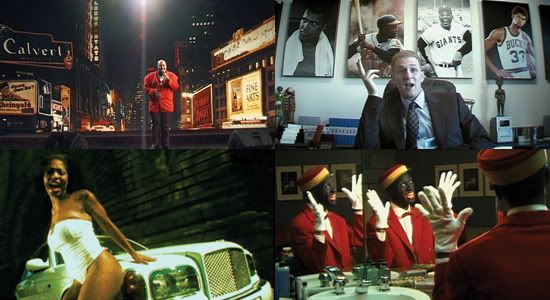
18. Bamboozled
Don't get cocky now, Spike. You are also responsible for one of the worst movies of the decade: that loathsome, interminable Miracle at St. Anna's. If it weren't for slavery, I'd demand reparations from you for that one. Alright, alright, so we’ll always have Bamboozled: with Tommy Hilnigger and Da Bomb, baby (it makes me get my freak on!)! And the guy who sings about smacking his hoes. And Mos’ Def’ as Big Black Africa with his posse of Mau-Maus. It’s a hilariously imaginative alternate reality that Lee has constructed, even though I don’t think I’m sold on the plausibility of minstrel shows returning to popular favor anytime soon. This stretching and pulling and general distorting of reality compounds with its highly documentary-like digital (consumer-grade cameras were used) presentation that confronts the viewer with a handful of wild ideologies that conflict and agree in different, often explosive ways. This is the territory in which the best Spike Lee films navigate. I can't explore much in such little space the politics of blackface and racial complicity of stereotyping in the entertainment industry, but I can say that the film feels very volatile. Very alive. In a film about performance, everyone impresses with theirs. "I... be smackin' my hoes!"
----------------------------------------------------------------------------------------------------------

17. Signs
My heart sings for the frequently slandered Shyamalan, whom I like. Signs is his best. Look at all the cool shots (like the knife under the door) and funny parts (like the military recruitment dude) and quality performances (like Mel Gibson's) and sweet (Hermanny) music and freaky bits (the Brazilian birthday video is a classic talking point)… The religion angle is a bit heavy, but then I think about how it is placed correlative to UFOs and I am somehow okay with it. His writing can sometimes achieve sonorous emotional highs - like that dinner table scene... oof. And to weave laughter into the thriller has been done by no one so deftly since Hitchcock, probably, though I'm told that's a cliched comparison. Really, to justify my admiration for Shyamalan's craft would, given the comprehensiveness of the opposition, take much more word power than I could jam into paragraph. Whatever. This movie is awesome and Joaquin Phoenix should do more comedy...
----------------------------------------------------------------------------------------------------------
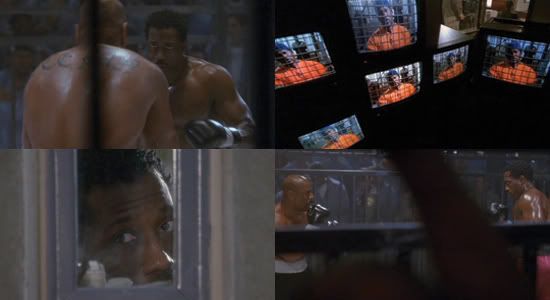
16. Undisputed
Walter Hill continues his interest in exploring territory theory in this jolting prison boxing picture that injects a strain of sophisticated meta-commentary on the gladiatorial nature not just of boxing but of the cinema that projects such demonstrations of ego on ego combat. Peter Falk paces about, saying "fuck!" all over the place, crinkle-eyed, sputtering, looking like his head is about to explode. Wesley Snipes internalizes and rages with equal strength and grace, like the best performances by Toshiro Mifune. Ving Rhames, I like. He is strong and passionate and has a mean face that you believe could kill you and a radiant goddamn smile. This is the machismo of prime time TNT, but given its heightened visual scheme (of cages, pens, screens, windows and television sets, and a periodic rapid, commercialized editing style resembling fight advertisements), specific address of racial and political thematic intent (much of which dealing with media depiction of fighters, particularly black fighters), and an impressive array of performance styles, it exposes the nerves and gears subsumed beneath the formula.
And hey, isn't it awesome that Fisher Stevens has an Oscar now!
----------------------------------------------------------------------------------------------------------
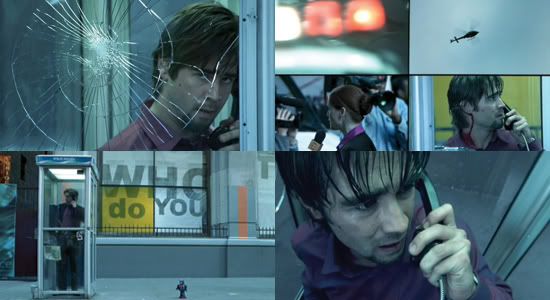
15. Phone Booth
Tense and tight, Schumacher demonstrates ample evidence for the argument that the surprising many who jerk their knees at him in dismissal (really, only for turning the Batman franchise into a cumbersome, laughable thing, a crime only dissimilar in shade to what the series has become with Nolan) run the risk of eating crow. It does seem that in this Scott Free world, there is little room for the MTV bombast of Schumacher, who seems old hat by comparison. Still, when it comes to at least this movie, which outclasses any Tony Scott film in existence and any Ridley Scott film made post-1977, Schumacher demonstrates visual wit and surety to spare, crafting a tight film based on a tight script (that somehow doesn't feel quite pared down enough sometimes), perfectly incorporating the spirit of the film's location and bustling atmosphere. I'll give it up for Colin Farrell, whose performance I think is one of the best I've seen. It's not realistic, but it's immediate--he guides you along with his actorly machinations and he's charismatic enough to pull it off. His swagger is mysterious, because we want to know how much is faked. Perfect casting. The metaphor is solid; at least the film knows it needs to be short. The ending is kinda goofy, but then the camera does a zoom out thing into the clouds and out of a phone receiver or something and it's even goofier.
----------------------------------------------------------------------------------------------------------
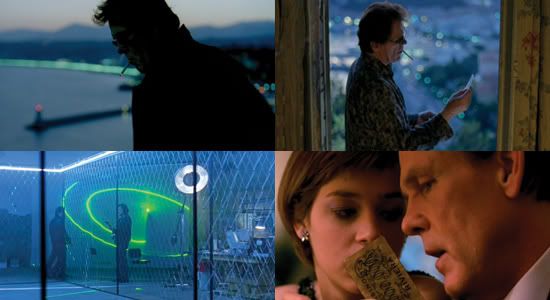
14. The Good Thief
After the sea of red herrings evaporates (and this is a very fishy plot indeed), the only thing in the film that in the end crystalizes is the presence, energy, face, voice, attitude—the style—of Nick Nolte. Nothing else matters: not the money, not the artwork nor the villain (Ralph Fiennes acted as the Fine Art Advisor to the film, punctuating the hilarity of his role--in one scene, he appraises a Picasso while holding a cigarette centimeters away from the canvas), not the girl, not his friendships (save maybe his amusing repartee with Tcheky Karyo, who plays a dogged detective looking to capture Nolte's "Bob le Flambeur" in the act), not his drug addiction, not the city (though Monte Carlo, especially in the perpetual dusk so important to the film’s mood, is nicely atmospheric), not even the heists (yes, there are several), which are labyrinthine and threaten to consume the casual viewer with their complex turnarounds, matter. For breezy, quasi-realistic, unpredictable Euro-glam criminal entertainment in the tradition of the masterful heist films of Jules Dassin (Topkapi & Rififi), the underrated Ocean's Twelve is respectable, but The Good Thief is tops.
----------------------------------------------------------------------------------------------------------
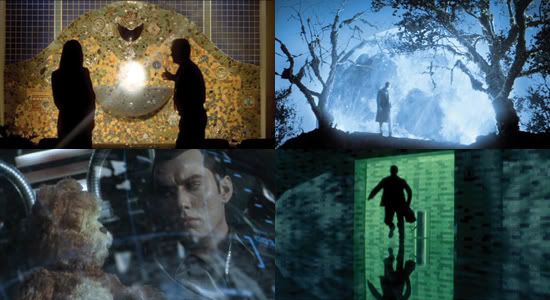
13. A.I. & The Terminal
It seems like most makers of Best Films of the 00s lists felt the need to include a 9/11 film, frequently either the overrated 25th Hour or the bombastic United 93. Props to Lee's film for dealing upfront with the tragedy (it was the first major film to address the attacks). Still, the sour mixture of Norton and Lee's respective self-absorption nerfs the resonance of Barry Pepper's pointed de-sexing, which echoes the loss of national virility. United 93 is simply pandering. Strangely, self-absorbed audience fodder is something that Steven Spielberg, who directed both AI & The Terminal, is often accused of making. What the 'berg brings with these two films that Lee and Greengrass don't is a strong sense of purpose and concise questioning (not to mention a much more interesting visual presentation). With The Terminal, it is true that consideration of terrorism is given very little screen time, which is a bit wonky since the film takes place in an airport terminal (post-9/11) and whose narrative impetus centers around civil unrest in a west Asian country. But the structured absence of topical weight allows for the film's admittedly heavy hand to fall on peripheral (or, in the present context, nonviolent) concerns. It is true that Zeta-Jones's character is horribly written and the actress certainly does the role no favors. But barring the cliched gooiness of that, The Terminal is a truly remarkable version of David and Goliath, both mythic in proportion and mundane at heart.
AI is in a strange bind, being made right before the attacks on Manhattan, but prevalently featuring an eerie, water-submerged Mecca (mecha) known as "MAN"hattan (the puns are stacking). Made right before the attack, AI projects New York into a future suggesting the irrelevancy of the human race. Chilling. AI is certainly the better film of the two, from a technical point of view, but also offers a world of immediate pleasures, but enough words have been written of its merits that I will leave it to you to seek them out. But I will say that Jude Law has never surpassed his Gigolo Joe, which is one of my favorite performances.
----------------------------------------------------------------------------------------------------------

12. The Fall
The mind in which The Fall takes place is all over the place. When fanciful, the film is projecting a story which is being projected by a man into the mind of a little girl: to whom do these images belong? Questions, questions, about looking and telling stories and projection and projection. Also: it's fun and quite nice to look at. As a work of cinema, rhythmic flow of image, compositional power, performative ambition, and aesthetic engagement of content, it is quite superior. Many complain about the girl's performance. They can go fuck themselves. She is a badass.
----------------------------------------------------------------------------------------------------------

11. Revolver
There's this scene at the end of this film where Jason Statham has a very long, complicated moment with himself in an elevator and it is as grand a moment as any I've seen this decade. I guess I still like Guy Ritchie (pretending that Swept Away was a bad dream), even with my better sense telling me to rethink it. This is easily his best, transcending his cherished labyrinthine-gangster-heist formula with some real groovy performances, including a Ray Liotta who reminds me in this, somehow, of a rabid mummified orangutan, yet still landing a few emotional sucker punches. The twisty plot things that it does are less interesting. We get it. But the psychology they explore is, if not really real or sound, at least in the same exciting, unpredictably cinematic spirit as Caligari.
----------------------------------------------------------------------------------------------------------

10. The Pledge
I like the barn full of turkeys, and the red and blue flashing lights, flashing all the time. And the crows. And the despair. Sean Penn can direct.
Note: watching this again, it is just as good if not better. Revisit highly advised.
----------------------------------------------------------------------------------------------------------
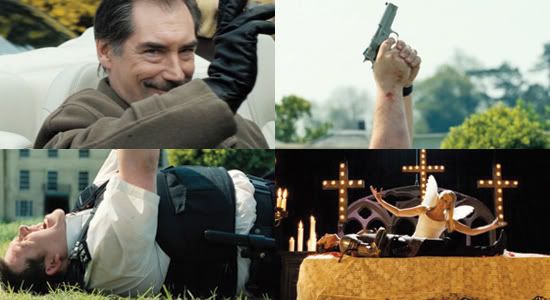
9. Hot Fuzz
Yeah, I guess beating up old people for a laugh was a bit of a cliche even at the time of the film's release. And in truth, and even though I did respond rather heartily to the violence inflicted on the elderly in Hot Fuzz, it's not the comedy that makes the film a keeper. If that were the case, may as well choose the less ambitious though more gag-filled Shaun of the Dead, a funny film that doesn't quite equal Hot Fuzz's expert control of theme and structure, nor are its purely cinematic moments so high. The throwback to Point Blank, where Nick Frost fires his gun up in the air and screams "Aaaaargh!" is a truly special moment, exquisitely (with great excitement and humor) demonstrating the depth to which we permit movies to seep into our everyday emotional lives. Also ending the stage adaptation of Baz Luhrmann's William Shakespeare's Romeo & Juliet with an arrangement of the Cardigans song from the film is another sprinkling of wittiness about the ubiquity (and inevitability) of reprocessed goods. Every single bit is hilarious, and Simon Pegg's performance is impressively straight, and thus all the more pleasurable to watch synchronize to the oddity surrounding him. Also, steeples, both full-sized and miniature, are scary now.
Note: watching this again, it is just as good if not better. Revisit highly advised. Such was the case, too, with Revolver.
----------------------------------------------------------------------------------------------------------
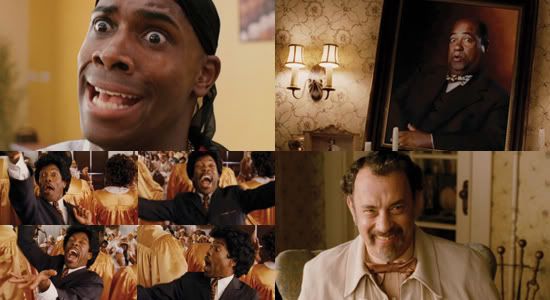
8. The Ladykillers
I suppose if I want to deflect accusations of contrarianism, I would choose the equally good No Country for Old Men as my requisite Coen Brothers pick. But I can't help it: this movie is so funny. It's so silly and so twisted. It's made great by the fact that it's visually immaculate. Gorgeous sets and exaggerated cinematography, even more than usual, taking place in a Looney Tunes universe as this film does, complete with its own mustachioed Foghorn Legorn in Tom Hanks's professor character (and so nice to see him doing comedy! I feel like I can't stress that enough), are punctuated by more gospel-heavy O Brother-like soundtrack, baptizing the viewer in a practically tactile atmosphere of cuckoo Southern comfort. There's even a short spastic choir leader, with a snazzy suit and massive hair. I cannot fathom this film's negative reputation.
Note: also great upon (several) revisit(s).
----------------------------------------------------------------------------------------------------------

7. The Darjeeling Limited
If push ever came right down to shove, I would have to admit that I’m prone to prejudice when it comes to independent cinema, in particular the brand popularized by W. Anderson, full of sensitive indie rock like Elliot Smith or oldie-but-goodies like The Kinks, colorful art design, oddball characters strongly identified by the ways in which they go about trying to act like they're not in a Conventional Hollywood Movie, and a selfish if not hermetic sentimentalism, relying mostly on the principle that people are apathetic jerks. It is a testament, then, to the strength of the genre's truths, however annoying or seemingly affected, that one of its progenitors, if not the guy that popularized many of the current trends, fails consistently to produce such intolerable product (or rather: succeeds in slicing through my curmudgeounliness). I don't like the prologue: Hotel Chevalier, which gave me indigestion. But the film proper's exploration of familial ties, a common Anderson trope, is strong, as are its sense of humor and (expectedly) killer art direction. I love the flashback to the garage especially.
Note: I saw within the past few days The Fantastic Mr. Fox, which is if not his best, his second best. I guess I would consider this interchangeable with that one for the time being.
----------------------------------------------------------------------------------------------------------
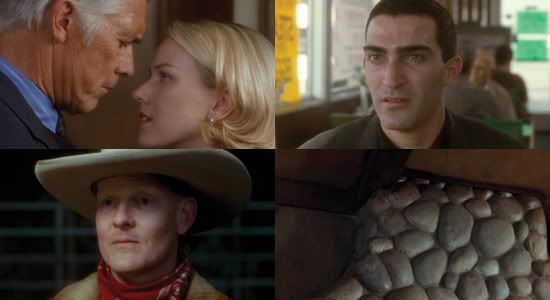
6. Mulholland Drive
I'll never forget the slow stretch of time where my cocky surety about the proceedings of Mulholland Drive gradually slipped from sound to completely imploded as all that I had taken for granted curved backwards in a pulse of light and bit me in the ass with teeth like jagged piano keys. Naomi Watts gives what has to be one of the best performances, on or off screen, ever. As with Eric Bana, I'm continually disappointed that she neglects to choose projects that allow her to showcase her clearly evident talent. Nobody has mastered the power of dream-logic more thoroughly than Lynch, whose movies are forever vague, despite their graphic strength. It's difficult, frequently, to find purchase, but if one readies for even just the pure experiential nature of Lynch's audio-visual flow, divorced from its complicated but engaging text, the fear, a profound, electric fear, will still slip in. The craft is so tactile, the content so elusive... how can this be?
----------------------------------------------------------------------------------------------------------

5. Monsters, Inc.
Only does that other lovely monster movie Monster House, if we're talking about the decade's CG escapades, come close to capturing the pitch between glee and horror that is so essential to the emotional life of a child that this film does so effortlessly. It's a funny, heart-warming, exciting tale that is successful in all the ways its publicity would have you believe it is. I often see it at the bottom of Pixar favorites lists, and I’ve seen it more than a handful of times, each time after seeing the latest Pixar of the time and, each time, more assured than the last that Monsters Inc is something special. So that confuses me. Its plotting (and plot in general) is very imaginative, to a degree that I don’t often see. And infused in its plot is an inescapable moral or two (about friendship and fear and comedy and things), blooming organically rather than tasting like aspartame. It is a wonderful and, given how well it communicates the spectrum of childhood feelings, resonant movie.
----------------------------------------------------------------------------------------------------------
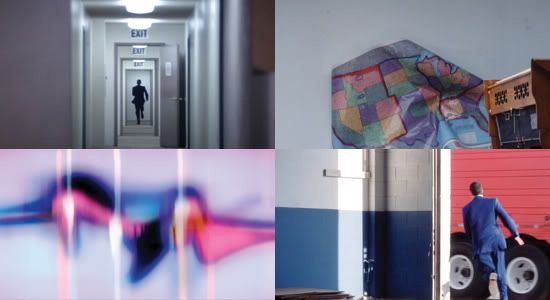
4. Punch-Drunk Love
God help me, I'm a sucker for this film. The last shot is a bit on-the-nosy for me, always leaving me with a slightly disappointed feeling as opposed to the clearly intended shiver of excitement. But the rest of the film, from shot one to the second-to-last shot, offers a surfeit of pleasures, more than enough to keep me, as a bobbing buoy in an expanse of ever-rowing water, afloat in an ether of ebullient cheer, far more terrific and lasting than the sliver of hope proposed by the film's end. The film's immediacy--its present tense--is so replete with tension and warmth and color and fear and light and love that watching it is, firstly, a purely sensational physical experience. The shock of the car and harmonium at the beginning lingers for the rest of the film, exacerbating that foundation of violent strangeness with romance and vice versa. And the pleasure of the dance of blue and pink on our eyes is real. Thankfully, the performances do the visual emotions justice, and it’s tight and a little peculiar. Even more than just in the borrowing of a song does Anderson have a debt to pay to Altman's Popeye, whose mumbling, awkward hero suffers severe blows to his humility, yet retains his optimism, inspired by love, in the face of the blunt violence of a senselessly evil oaf.
----------------------------------------------------------------------------------------------------------
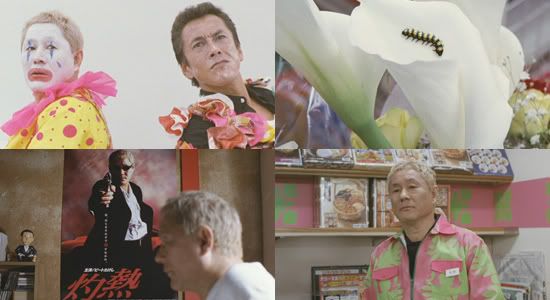
3. Takeshis'
I guess I take to movie puzzles that shift and shade one's perspective in ways both thrilling and subtle, particularly through editing. Kitano's penchant for set pieces and his love of theater are twisted into a maze of dreams, fantasies, films, and some form of "Kitano reality" that is generally highly questionable in the first place. The second time I saw it, I was able to piece together more of the puzzle, but found some of my answers gave rise to more questions. The best part about Takeshis is that even with its headiness, it is, from moment to moment, always exhilarating. Kitano is prone to peer, ponderously, frequently, with a static camera and still faces, and there is some of that here, but never as "purely" photographic moments or to allow the viewer a break for contemplation: under each moment of quiet, there is a train of mental energy, propelled by the mysterious emotional life of a character suicide/assassination by personae deconstruction. That sounds confusing, but watch it. It has crazy cool dance numbers.
Note: this movie is, on a rewatch, utterly impressive (then, I am fascinated intricately structural things). May as well be #1.
----------------------------------------------------------------------------------------------------------

2. The White Diamond & The Wild Blue Yonder
Most of these decade lists featured Grizzly Man, if not pairing it in this same cheaty way with The White Diamond, a rapturous film which features a moment where a young man pays tribute to Michael Jackson on the edge of a waterfall. In The Wild Blue Yonder there is a moment where a diver is swimming upward to resurface and the oxygen mask's decompression bubbles combined with the sun filtering into the water through the hole carved into the ice above create the illusion of the diver being transformed into pure light energy. That moment alone makes it one of the worthiest films, better in many ways to the equally recommendable Grizzly Man. But with this one, the viewer is also given ample time to spend with Brad Dourif’s despairing alien, whose ranting is funny and intense and I cannot look away. The footage in the film (both of these films, actually) is also jaw-droppingly impressive. Beautiful, evocative, and with trademark bone-rattling choral classical chamber chant fusion soundtrack. The films work together the way sky and water do. And their ambition is similar: maneuvering the physical through the ether.
----------------------------------------------------------------------------------------------------------

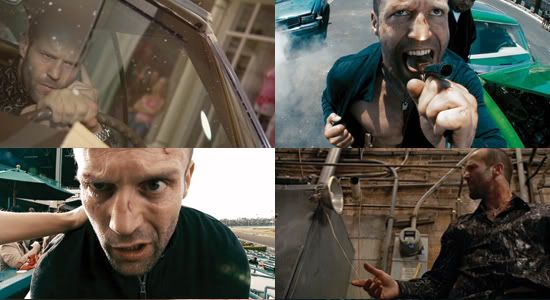
1. Crank & Crank 2: High Voltage
Seemingly entropic, much more than the violently one-tracked trajectory of the first film, the brazen High Voltage escalates Chev Chelios's existential plight by graduating his fuel from the personal (adrenaline) to the inter-personal (electricity). This model was likely not developed by writer/directors Neveldine/Taylor to consciously inspect the human condition--I'm not sure that consciousness has much to do with it at all. The Crank films explore existence as pure physical form. They are indirectly about the ways in which we choose to live amongst each other, physically. Latent racism, deviant sex, homophobia, the ghettos-to-Beverley-Hills, the breadth of Crank's vision of the civic practices, not theories, of a multi-cultural Metropolis is inspiring. When I see Crank, I am seeing not just a depiction of the tensions of kaleidoscopic American citizenry in action, but also a production that incorporates and invigorates and defines this tapestry. It does so frequently in troubling terms (Bai Ling is very difficult to get used to--just in general, but especially in High Voltage), but those terms can be empowering. That is a defense to mount in depth elsewhere, but I think it wouldn't be a stretch to say, whether you love the films or not, whether they offend you or not, that they are a unique take on cultural eclecticism that encourage the exploration of symbiotic dynamics within the hectic world they channel hectically.
----------------------------------------------------------------------------------------------------------
Thanks for reading!
